Eastern Hog-nosed Snake
Heterodon platirhinos, commonly known as the eastern hog-nosed snake, spreading adder, or deaf adder, is a harmless colubrid species endemic to North America. No subspecies are currently recognized. Generally found from eastern-central Minnesota, and Wisconsin to southern Ontario, Canada and extreme southern New Hampshire, south to southern Florida and west to eastern Texas and western Kansas.
The average adult measures 28" in total length (body + tail), with females being larger than males. The maximum recorded total length is 46". The most distinguishing feature is the upturned snout, used for digging in sandy soils.
The color pattern is extremely variable. It can be red, green, orange, brown, gray to black, or any combination thereof depending on locality. They can be blotched, checkered, or patternless. The belly tends to be a solid gray, yellow, or cream-colored. In this species the underside of the tail is lighter than the belly.
Although H. platyrhinos is rear-fanged, it is often considered nonvenomous because it is not harmful to humans. Heterodon means "different tooth", which refers to the enlarged teeth at the rear of the upper jaw. These teeth inject a mild amphibian-specific venom into prey, and also are used to "pop" inflated toads like a balloon to enable swallowing. Bitten humans who are allergic to the saliva have been known to experience local swelling, but no human deaths have been documented.
The Eastern hognose snake feeds extensively on amphibians, and has a particular fondness for toads. This snake has resistance to the toxins toads secrete. This immunity is thought to come from enlarged adrenal glands which secrete large amounts of hormones to counteract the toads' powerful skin poisons. At the rear of each upper jaw, they have greatly enlarged teeth, which are neither hollow nor grooved, with which they puncture and deflate toads to be able to swallow them whole. They will also consume other amphibians, like frogs and salamanders.
They mate in April and May. The females, which lay 8 - 40 eggs (average about 25) in June or early July, do not take care of the eggs or young. The eggs, which measure about 1 1⁄4" × 1", hatch after about 60 days, from late July to September. The hatchlings are 6.5"–8.3" long.

By Kevin Faccenda. CC BY 2.0, via Flickr

By Virginia State Parks. CC BY 2.0, via Flickr
